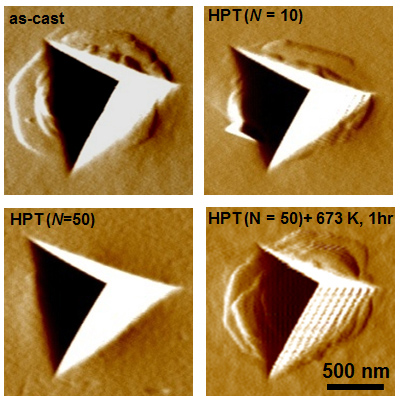Discovery of Anomalous Softening Phenomenon and Shear Bands Suppression Effect in Metallic Glass
Suggests the Possibility of Room Temperature Forming of Metallic Glass by Utilizing “Structural Rejuvenation
2012.09.24
(2012.11.15 Update)
National Institute for Materials Science
A team headed by Dr. Koichi Tsuchiya, Deputy Unit Director of the NIMS Structural Materials Unit, in joint research with the Institute for Materials Research, Tohoku University, discovered an anomalous softening effect in metallic glass, in which the hardness and elastic modulus of the material are reduced remarkably by applying giant shear strain to metallic glass under a high pressure of 5GPa.
Abstract
- A team headed by Dr. Koichi Tsuchiya, who is the Deputy Unit Director of the Structural Materials Unit (Unit Director: Kaneaki Tsuzaki) and was a Visiting Professor at the Institution for Materials Research, Tohoku University from April 1, 2012 to September 30, 2012, Dr. Fanqiang Meng, a NIMS Junior Researcher, and Dr. Seiichiro Ii, a Senior Researcher, both of the structural Materials Unit, in joint research with the Advanced Research Center of Metallic Glasses (Head: Prof. Akihiro Makino) of the Institute for Materials Research (Director: Mitsuo Niinomi), Tohoku University, discovered an anomalous softening effect in metallic glass, in which the hardness and elastic modulus of the material are reduced remarkably by applying giant shear strain to metallic glass under a high pressure of 5GPa. This research revealed that the shear zones generated in metallic glasses during room temperature deformation are suppressed accompanying this anomalous softening.
- Metallic glasses are a type of amorphous metallic material and have excellent properties, such as high strength, high corrosion resistance, soft magnetism, etc. in comparison with ordinary metals. Metallic glasses display these favorable properties because they do not have a periodic structure like that of crystalline metallic materials, and therefore do not have the dislocations and grain boundaries associated with crystal structures. Utilizing these excellent properties, metallic glasses have already been applied to magnetic devices, golf clubs, projection materials for use in shot peening, etc. However, their range of applications had been limited, as metallic glasses lack ductility and are prone to localized deformation when deformed at room temperature.
- Using the nanoindentation method, the team headed by Dr. Tsuchiya investigated the changes in the mechanical properties of a disk-shaped specimen of Zr50Cu40Al10 metallic glass when shear strain was applied by the high pressure torsion (HPT) method, in which giant torsional straining is applied under a high pressure of 5GPa at room temperature. As a result, the hardness and modulus of elasticity decreased as deformation increased, and after 50 revolutions of HPT straining, the hardness and elastic modulus of the specimen were markedly decreased to 22% and 30% of the values before straining, respectively. This is attributable to the phenomenon of “structural rejuvenation,” in which the atomic level structure of the metallic glass becomes more liquid-likeunder HPT.
- Furthermore, when the indentation marks after nanoindentation were observed by scanning probe microscopy (SPM), numerous shear bands could be seen in the area around the indents before straining, but the number of shear bands decreased with increasing HPT straining, and no shear bands were observed after 50 revolution of HPT straining. This shows that localized deformation is suppressed by HPT straining, and the material undergoes a transition to a more homogeneous deformation mode. This discovery suggests the possibility of room temperature formingof metallic glasses, and is considered to enable development of applications to micro-to-nano systems, etc.
- This research result was obtained with the support of the Ministry of Education, Culture, Sports, Science and Technology (MEXT) Grants-in-Aid for Scientific Research on Innovative Areas, “Bulk Nanostructured Materials” and the National Collaborative Research Program of the Advanced Research Center of Metallic Glasses of the Institute for Materials Research, Tohoku University. These results were published in Applied Physics Letters dated September 20, 2012. An abstract can be found at the following address: http://apl.aip.org/resource/1/applab/v101/i12/p121914_s1?bypassSSO=1

Figure 2: Changes in scanning probe microscope images of nanoindentationmarks under straining by HPT and thermal annealing (400°C, 1hr).
